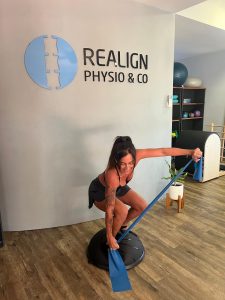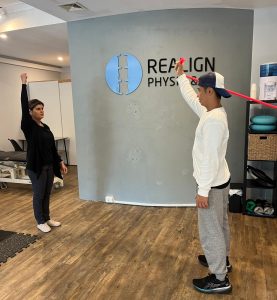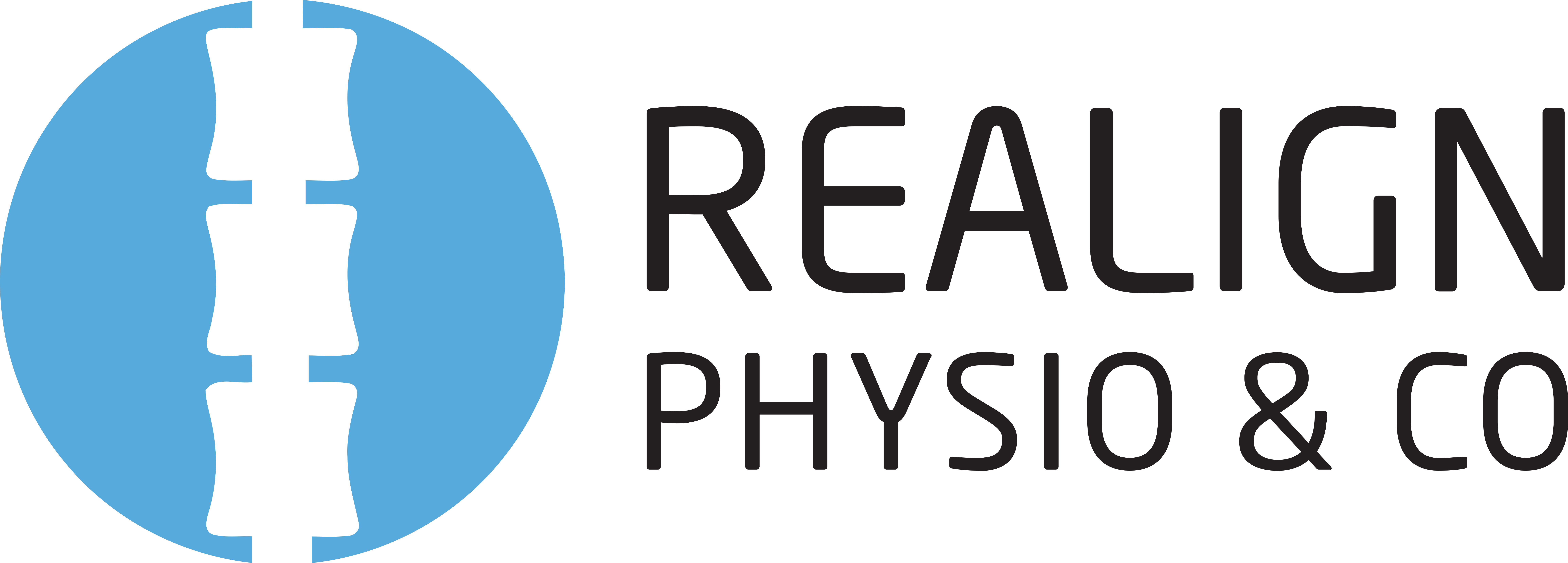Surf Smart: Common Injuries & How to Prevent Them

Surfing is an incredible way to stay fit, enjoy the outdoors and connect with the ocean — but like any sport, it can place unique demands on your body. At Realign Physio & Co, we’ve been seeing more surfers lately (no surprise with so many great breaks here on the Gold Coast!) experiencing similar aches, pains and injuries.
The good news? With the right preparation and care, most of these issues can be prevented or managed.
Most Common Surfing-Related Injuries🏄
1. Shoulder Pain
Paddling puts a lot of repetitive stress on the shoulders, especially the rotator cuff muscles. This can lead to overuse injuries like tendinopathy or impingement.
Prevention Tip: Strengthen your rotator cuff and upper back muscles, and make sure you warm up before you paddle out.
2. Lower Back Strain
Arching the spine while paddling can irritate the lower back or cause muscle strains. Surfers often describe stiffness or soreness after longer sessions.
Prevention Tip: Improve your core stability and flexibility through exercises like Pilates or targeted physiotherapy programs.
3. Neck Tightness
Keeping your head lifted for long periods can strain the neck muscles and joints.
Prevention Tip: Include regular neck mobility and stretching exercises in your routine. Short breaks to rest your neck between sets can also help.
4. Knee & Ankle Injuries
Rapid pop-ups, twists and landings in unstable positions can stress the knees and ankles, sometimes resulting in sprains or ligament strains.
Prevention Tip: Work on balance, proprioception and leg strength off the board — single-leg exercises and wobble board drills are great options.
How Physiotherapy Can Help
Physiotherapists understand the specific demands of surfing. Whether you’re recovering from an injury or trying to prevent one, a tailored program can:
Improve your paddling and pop-up mechanics
Strengthen key muscle groups
Enhance flexibility and balance
Reduce pain and speed up recovery
At Realign Physio & Co, we offer personalised rehab and conditioning plans for surfers of all levels — plus Pilates and exercise physiology sessions to build resilience and keep you in the water longer.
Takeaway Message
Surfing is tough on the body, but it doesn’t have to lead to pain. By investing a little time into injury prevention and proper recovery, you can enjoy more sessions and fewer setbacks — whether you’re catching waves on the Gold Coast or beyond.
Need help with a surf-related ache or injury? Book an appointment with our team today and get back to doing what you love.
What is a Rotator Cuff Tear — and Do You Really Need Surgery?

The rotator cuff is a group of four muscles that connect your shoulder blade (scapula) to your upper arm bone (humerus). These muscles are:
Subscapularis – located on the front of the shoulder blade
Supraspinatus – sits on top of the shoulder blade
Infraspinatus – found on the back of the shoulder blade
Teres minor – also on the back of the shoulder blade
While each muscle helps with specific movements like lifting your arm, rotating it inwards or outwards, their most important role is dynamic stability—keeping the shoulder joint controlled and supported during all movements.
Common Causes of a Weak or Painful Shoulder
Shoulder pain generally falls into three broad categories:
Stiff Shoulder – for example, frozen shoulder (adhesive capsulitis)
Unstable Shoulder – usually following dislocations or subluxations
Weak & Painful Shoulder – including conditions such as:
Shoulder impingement
Subacromial pain syndrome
Rotator cuff tendinitis, tendinosis, or tendinopathy
Rotator cuff tears
Many people assume that imaging, injections, or surgery are required to treat these issues. In reality, exercise therapy is usually the first-line treatment. Shoulder pain often relates more to current tissue sensitivity from activity changes or overall health factors than to structural damage like a new tear or severe inflammation.
For instance, rotator cuff tears are surprisingly common in people without any symptoms, and their prevalence increases with age. Research shows that these tears don’t always affect function or cause pain:
Surgery is not always necessary. Evidence suggests that non-operative management is as effective as surgery for many rotator cuff tears, including both partial and full-thickness tears. In fact, nearly half of full-thickness tears can be asymptomatic.
Understanding Pain and Recovery
Rotator cuff tears are often thought to be like a rope that’s been cut, but a better analogy is a small hole in a piece of cloth—the cloth (aka the shoulder) can still function well despite the tear.
This means that experiencing some discomfort during rehab is normal and safe, as long as it’s manageable and progressively improves over time. Symptoms are usually linked to the shoulder being sensitive to certain positions or movements, not irreparable damage.
The goals of rehab are straightforward:
Temporarily modify activities that aggravate the shoulder
Improve overall health through lifestyle and exercise
Address deficits in strength, range of motion, and confidence with a manageable and progressive exercise program
With the right approach, most people can safely return to their normal activities, improve function, and reduce pain—all without immediately resorting to surgery.
If you have been told you have a rotator cuff tear and would like to know what you can do to help, book in for an appointment at Realign Physio & Co. Our team can guide you through tailored exercises, pain management strategies, and support your recovery.
How Exercise Physiology Helps with Managing Chronic Conditions

Living with a chronic condition can impact far more than just your physical health. Whether you’re managing ongoing back pain, arthritis, or recovering from injury, it can affect your confidence, mobility, performance and overall quality of life.
Exercise Physiology offers a safe, personalised way to improve movement, reduce symptoms, and support long-term function — even when other treatments haven’t been enough on their own.
What Is Exercise Physiology?
Exercise Physiologists are university-qualified allied health professionals who specialise in clinical movement therapy. Their role is to prescribe exercise based on a person’s medical history, functional capacity, and long-term goals.
Exercise Physiology isn’t about fitness for the sake of it. It’s about:
- Understanding how your body responds to movement
- Improving strength, stability, and mobility
- Reducing symptoms like pain, stiffness, or fatigue
- Helping you stay active and independent for longer
Musculoskeletal Focus: Building Strength Around Pain and Injury
At Realign Physio & Co, we most commonly support clients with chronic or complex musculoskeletal conditions. These include:
- Returning to Sport After Injury or Surgery: We support safe, progressive return to sport following injury or surgery. Our tailored programs rebuild strength, restore confidence, and reduce re-injury risk — helping you get back to what you love.
- Persistent back or neck pain
Improving spinal control, strength, and endurance can reduce discomfort and improve your ability to handle everyday tasks. - Arthritis and joint degeneration
Exercise helps preserve joint range of motion, reduce stiffness, and support the muscles that stabilise affected areas. - Tendon injuries (e.g. Achilles, gluteal, shoulder)
Progressive loading is a proven strategy for helping tendons heal and regain their strength and capacity. - Joint hypermobility and instability
Targeted movement can improve control, reduce strain on joints, and help prevent injury through better support and coordination.
Beyond the Muscles and Joints
While musculoskeletal conditions are common, Exercise Physiology also plays a key role in managing non-musculoskeletal chronic conditions, such as:
- Type 2 diabetes – Exercise improves insulin sensitivity and supports blood glucose management.
- Chronic fatigue or fibromyalgia – Gentle, structured movement helps reduce flare-ups and improve energy regulation.
- Mental health conditions – Regular movement is shown to improve mood, sleep, and stress levels, especially when tailored to the individual.
- Neurological conditions – For those with conditions like MS or Parkinson’s, exercise can help preserve motor control, strength, and mobility.
An Exercise Physiologist is trained to modify programs for complex health needs, ensuring movement is safe, manageable, and supportive of long-term wellbeing.
Why Not Just Go to the Gym?
The gym can be helpful for many people, but for those managing chronic pain, fatigue, or injury, it’s not always the right place to start. It’s common to feel unsure about what’s safe, which exercises to avoid, or how to pace yourself — and without guidance, this can lead to flare-ups, frustration, or giving up altogether.
An Exercise Physiologist takes the guesswork out.
They help you:
- Understand your limits — and how to work within them
- Build strength and function progressively
- Learn how to move without aggravating symptoms
- Regain trust in your body, at your own pace
Whether you’re just starting out or returning to movement after a long break, an AEP ensures your program is safe, individualised, and clinically appropriate.
The Goal: Movement That Works for You
Many people living with chronic conditions avoid exercise because they fear doing more harm than good — especially if previous attempts led to setbacks. But the right movement, introduced gradually and with support, can help you feel stronger, more capable, and more in control.
At Realign Physio & Co., we work closely with clients to create sustainable programs that fit your body and your lifestyle. Whether you’re recovering from injury, living with persistent pain, or managing a long-term condition, Exercise Physiology can help guide your next step forward.
Why Do Injuries Increase in Cold Weather?

As the cooler months settle in, we often see a spike in injuries—especially muscle strains, joint pain, and flare-ups of old issues. But why does this happen? And more importantly, how can you protect yourself through winter?
Stiff Joints and Tight Muscles
When temperatures drop, your muscles naturally tighten and lose some of their elasticity. Cold weather also causes blood vessels to constrict, reducing circulation. This can limit mobility and make your muscles and joints feel stiff or sluggish—creating a higher risk of strains, sprains, or tendon injuries, especially if you jump into exercise without warming up properly.
Old Injuries Can Resurface
Many people notice previous injuries or chronic conditions—like arthritis, lower back pain, or knee problems—flare up in winter. Cooler temperatures can affect joint fluid viscosity and muscle tension, making pre-existing problems more noticeable or even painful.
Common Winter Injuries
At Realign Physio & Co, we often see:
Hamstring and calf strains (especially in runners and gym-goers)
Lower back pain from poor lifting technique or sudden movements
Slips and falls, particularly on wet or icy surfaces
Neck and shoulder tightness from poor posture or hunching to stay warm
How to Stay Injury-Free This Winter
The good news? A few smart habits can make all the difference.
Warm up properly. Take at least 5–10 minutes to get the body moving before any exercise. Think dynamic stretches or light cardio to raise your core temperature.
Stay mobile. Even on rest days, light movement like walking, Pilates, or mobility exercises can help keep stiffness at bay.
Dress in layers. Keeping your muscles warm helps maintain flexibility and reduces injury risk—especially for early-morning sessions.
Listen to your body. If something feels “off,” don’t push through it. It’s easier to manage a niggle than a full-blown injury.
Book in for a check-up. Winter is a great time to work on strength, mobility, and recovery with your physio, exercise physiologist, or massage therapist.
Need Support This Winter?
Whether you’re managing an old injury or want to keep your body strong and pain-free through the colder months, our team is here to help. We offer physiotherapy, exercise-based rehab, massage, and tailored Pilates to support you all year round.
Spondy-What? Untangling Common Spine Conditions

Back pain can be confusing, especially when complicated terms are thrown around. Ever been told you’ve got spondylolysis, spondylolisthesis, spondylitis, or spondylosis—and had no idea which one meant what? You’re not alone. These tongue-twisters sound similar but each describes a different issue in the spine. Here’s a clear breakdown of what they mean, how they show up, and what might help.
Spondylolysis
Spondylolysis is a type of stress fracture that occurs in a small part of the vertebra near the back of the spine called the pars interarticularis. It most often affects teenagers or young adults involved in sports that include repeated spinal movements like bending backward or twisting—such as gymnastics, cricket, or diving.
While not always painful, some people notice an ache or discomfort in the lower back, especially during activity. Diagnosis involves a clinical assessment and may include imaging like an X-ray or MRI if needed.
If left unaddressed, spondylolysis can sometimes progress to spondylolisthesis, where one vertebra begins to shift forward over another—so early identification and management can be important.
Spondylolisthesis
Spondylolisthesis happens when one vertebra slips slightly forward compared to the one below it. In younger people, this often follows a stress fracture like spondylolysis. In older adults, it may develop gradually due to natural changes in the spine’s structure over time.
Some people feel no symptoms at all, while others experience lower back pain, tightness through the legs, or occasional tingling or heaviness. Clinical examination and imaging help determine how much movement has occurred and whether nerves are affected.
Spondylitis
Spondylitis refers to inflammation of the spine. The most well-known type is ankylosing spondylitis, which often begins in early adulthood and causes stiffness in the lower back or hips—especially after rest or in the early morning.
Diagnosis is based on your clinical history and may involve blood tests or MRI to look for signs of inflammation. While it’s a long-term condition, early diagnosis and regular movement can make a big difference in how it progresses and how you feel day to day.
Spondylosis
Spondylosis describes age-related changes in the spine, similar to the natural wear and tear that can occur in other joints. The discs between the vertebrae may lose some of their cushioning over time, and small bony changes or joint stiffness may develop.
It’s extremely common—about one in three people may have signs of spinal osteoarthritis on imaging without any symptoms at all. When symptoms do occur, they might include stiffness in the morning, aching after long periods of sitting or standing, or occasional nerve irritation.
Importantly, the severity of changes seen on imaging doesn’t always match how a person feels. Many people with significant changes remain active and mobile, and symptoms are often manageable with the right supports in place.
What Can Help?
If you’re dealing with one of these conditions—or simply wondering if your symptoms might be related—conservative management is often a good place to start.
Physiotherapy: Assess movement, strength, and posture to create a plan that fits your goals and lifestyle.
Exercise physiology: Build long-term strength and conditioning, either individually or in small group classes.
Massage therapy: Help relieve muscle tension contributing to discomfort.
: Improve spinal stability and mobility with programs tailored to your needs, which can be highly effective in managing back pain and enhancing function.
Have a look at or ask us about our individual and small group Pilates sessions to see if they might be right for you.
If you’re unsure where to begin, a physiotherapy assessment can help guide your next steps and connect you to the right supports.
Workplace Injuries and Physiotherapy

Workplace injuries can happen to anyone—whether you work at a desk, in a warehouse, or on a construction site. Fortunately, many of these injuries are preventable with the right knowledge and practices. And if an injury does occur, physiotherapy plays a key role in helping you recover and get back to work safely.
Common Work Injuries
Some of the most common workplace injuries include:
Sprains and strains from lifting or repetitive movement
Lower back pain from poor posture or heavy lifting
Neck and shoulder tension from prolonged desk work
Falls, slips, or trips
Joint injuries from overuse or awkward movement
How to Avoid Work Injuries
1. Safe Lifting Techniques
If your job involves lifting, remember these basics:
Bend your knees
Keep the load close to your body
Avoid twisting while lifting—turn your whole body instead
Ask for help with heavy or awkward loads
2. Safe Workplace Practices
Keep your work area clean and free of clutter
Use tools and equipment correctly and as instructed
Take regular breaks to reduce fatigue and overuse
Report any hazards immediately
3. Basic Ergonomic Tips
Even desk jobs come with risks. To support your body throughout the day:
Adjust your chair so your feet are flat on the floor
Keep your screen at eye level
Use a headset for phone calls if you’re on the phone often
Take short breaks to stand, stretch, and reset your posture
What to Do If You Have a Work Injury
If you’ve been injured at work, it’s important to:
Report the injury to your employer as soon as possible.
Seek medical advice—early assessment is key to recovery.
Make a WorkCover claim if you’re eligible, so you can access appropriate treatment and support.
How Physiotherapy Can Help
Physiotherapists are trained to assess and treat a wide range of work-related injuries. At Realign Physio & Co, we focus on:
Reducing pain and inflammation
Restoring strength, flexibility, and movement
Providing return-to-work programs tailored to your job role
Preventing re-injury with education and exercise-based rehab
We work closely with GPs, insurers, and case managers to support your recovery, ensuring you’re not just returning to work—but returning safely and confidently.
Enhancing Mobility and Quality of Life with Parkinson's PhysiotherapyPhysiotherapy for Parkinson’s Disease: Enhancing Mobility and Quality of Life

April is Parkinson’s Awareness Month, with World Parkinson’s Day on April 11th—a time to raise awareness and highlight the importance of early intervention and effective management strategies. Parkinson’s disease is a progressive neurological condition that affects movement, balance, and coordination. While there is no cure, physiotherapy plays a crucial role in managing symptoms and improving the overall quality of life for individuals with Parkinson’s.
How Does Physiotherapy Help?
Physiotherapy is essential in maintaining mobility, preventing falls, and enhancing daily function.
It focuses on:
- Improving Balance and Coordination – Parkinson’s can cause postural instability, making individuals more prone to falls. Physiotherapists use exercises that enhance balance and spatial awareness.
- Increasing Mobility and Flexibility – Stiffness and rigidity are common symptoms. Stretching and mobility exercises help maintain movement and reduce discomfort.
- Strength and Endurance – Muscle weakness can develop over time. Strength training and aerobic exercises boost endurance and overall physical function.
- Gait Re-training – Parkinson’s affects walking patterns, often leading to shuffling steps. Physiotherapy incorporates techniques to encourage longer strides and better posture.
- Cueing Strategies and Functional Training – Physiotherapists use external cues (like rhythmic auditory stimulation or visual markers) to help patients with movement initiation and coordination.
Common Physiotherapy Techniques for Parkinson’s
Several evidence-based approaches are effective for Parkinson’s patients:
PD Warrior – is an exercise-based rehabilitation program designed specifically for people with Parkinson’s disease. It focuses on neuroplasticity principles to slow disease progression and improve function.
Balance and Resistance Training – Incorporates stability exercises, core strengthening, and resistance workouts to enhance physical capabilities.
Functional Task Practice – Exercises that mimic daily activities, such as getting up from a chair or walking on different surfaces, to improve independence.
When to See a Physiotherapist?
It’s never too early to start physiotherapy. Early intervention can help slow the progression of movement difficulties and allow individuals to maintain independence for longer. If you or a loved one has Parkinson’s and is experiencing stiffness, balance issues, or difficulty walking, consulting a physiotherapist can provide tailored strategies to manage symptoms effectively.
Final Thoughts
Physiotherapy is a key component of Parkinson’s care, offering tools to improve mobility, strength, and confidence in movement. With the right exercises and support, individuals can stay active and maintain their quality of life.
At Realign Physio & Co, we offer personalised physiotherapy sessions to support your journey with Parkinson’s. We are also planning to introduce group classes focused on Parkinson’s and other neurological conditions. Ask our team for more information.
Pilates History and MarchMatness

The History of Pilates
Pilates is more than just an exercise method—it’s a practice with a rich history and a global following. Understanding its origins provides insight into its lasting impact on health and movement.
The Origins of Pilates
Joseph Pilates, the creator of the Pilates method, was born in Germany in 1883. As a child, he suffered from various health conditions, including asthma and rickets. Determined to strengthen his body, he studied a range of physical disciplines, including gymnastics, yoga, and martial arts.
During World War I, Pilates was interned in England, where he refined his training techniques, helping fellow internees improve their strength and mobility. This period was instrumental in the development of his Contrology method, which later became known as Pilates. After the war, he moved to the United States and, with his wife Clara, opened a studio in New York City in the 1920s. His method gained popularity among dancers, athletes, and those seeking rehabilitation from injuries.
The Development of the Pilates Method
Joseph Pilates’ approach to exercise was centered on the idea that physical and mental health are deeply interconnected. He believed in training the body through controlled and precise movements, emphasizing core strength, flexibility, and breathing.
Pilates developed a series of exercises that could be performed both on the mat and using specialised equipment, such as the Reformer and Cadillac. His method was particularly embraced by the dance community, as it helped improve alignment, strength, and injury prevention. Over time, Pilates expanded beyond dance and was adopted by athletes, rehabilitation professionals, and fitness enthusiasts worldwide.
The Evolution and Global Influence of Pilates
Following Joseph Pilates’ passing in 1967, his students, known as the “Pilates Elders,” continued to teach and expand upon his method. As the practice grew in popularity, different styles and variations emerged, ranging from classical Pilates, which stays true to the original teachings, to contemporary adaptations incorporating modern biomechanics and rehabilitation techniques.
Today, Pilates is practiced globally in studios, gyms, and rehabilitation centers. Its benefits are widely recognised for improving posture, core stability, flexibility, and overall well-being. Despite its evolution, the core principles of Pilates — control, concentration, precision, breath, flow, and centering — remain the foundation of its practice.
March MATness: A Celebration of Pilates History
One of the ways the Pilates community honors its history is through March MATness, an annual event that celebrates the original 34 mat exercises designed by Joseph Pilates. Started in 2013 by Pilates instructor Benjamin Degenhardt, March MATness encourages practitioners around the world to revisit and share these foundational exercises throughout the month of March.
Each day in March, participants focus on a different mat exercise, sharing insights, modifications, and experiences through social media and local Pilates communities. This movement not only spreads awareness of the method but also deepens appreciation for its origins and principles.
Experience Pilates at Realign Physio & Co
At Realign Physio & Co, we honor the legacy of Joseph Pilates by offering expert-led classes that help you build strength, flexibility, and coordination. Whether you’re a beginner looking to explore the fundamentals or an experienced seeking to refine your technique, our sessions cater to all levels.
Elbow and Triceps Tendinopathy: understanding and managing your pain

Elbow and triceps tendinopathy are common conditions affecting the tendons around the elbow, often seen in individuals who perform repetitive wrist, forearm, or pushing movements. Whether you’re an athlete, a manual labourer, or someone who spends long hours at a desk, these conditions can significantly impact your daily activities and performance.
What Are Elbow and Triceps Tendinopathy?
Elbow and triceps tendinopathy refer to pain and dysfunction in the tendons that attach to the elbow, typically classified as either:
• Lateral elbow tendinopathy (Tennis Elbow): Affecting the extensor tendons on the outer part of the elbow, commonly seen in racket sports, repetitive gripping, or heavy lifting.
• Medial elbow tendinopathy (Golfer’s Elbow): Involving the flexor tendons on the inner elbow, often caused by repetitive wrist flexion, throwing sports, or occupational activities.
• Triceps tendinopathy: Affecting the tendon at the back of the elbow, often caused by excessive pushing movements, weightlifting, or repetitive forceful elbow extension.
Contrary to past beliefs, these conditions are not driven by inflammation but by changes in the tendon structure due to excessive load. This is why traditional anti-inflammatory treatments like corticosteroid injections are not recommended as a long-term solution.
Recognising the Symptoms
• Localised pain on either the inside (medial), outside (lateral), or back (posterior) of the elbow.
• Increased discomfort with gripping, lifting, wrist movements, or pushing activities.
• Morning stiffness and tenderness around the elbow.
• Reduced grip strength, forearm fatigue, or difficulty with overhead or pressing movements.
• Pain that may temporarily ease during activity but worsen afterward.
Why Does It Happen?
Elbow and triceps tendinopathy are overuse injuries, meaning the tendons have been subjected to excessive or repetitive stress without adequate recovery. Some common contributing factors include:
• A sudden increase in workload (e.g., starting a new sport, lifting heavier weights, or increased manual labour).
• Poor grip technique, pushing mechanics, or improper equipment use.
• Weakness in surrounding muscles leading to increased tendon strain.
• Repetitive wrist, forearm, or elbow extension movements with inadequate recovery
Managing Elbow and Triceps Tendinopathy.
Recovery requires a combination of movement modification and progressive strengthening rather than complete rest. A physiotherapist can guide you in:
• Adjusting activities to reduce strain while maintaining function.
• Gradually strengthening the tendon through specific exercises suited to your condition.
• Addressing contributing factors such as movement patterns, grip strength, and ergonomic adjustments.
• Using symptom management strategies such as manual therapy to address muscle tension, while exercise remains the key to long-term recovery
Preventing Reinjury.
Once symptoms improve, it’s essential to gradually return to normal activities while continuing to build tendon resilience. A physiotherapist can help you implement strategies to prevent recurrence, such as:
• Ensuring a gradual return to sport, gym, or occupational tasks.
• Strengthening surrounding muscles to support the tendon.
• Improving technique and biomechanics to reduce excessive strain.
Seeking Professional Guidance
Elbow and triceps tendinopathy require a structured approach for long-term improvement. While self-management strategies can provide temporary relief, targeted rehabilitation is essential for full recovery. A physiotherapist can assess your condition, guide you through a progressive strengthening program, and help you modify activities to prevent reinjury.
For personalised advice and treatment, book an appointment with one of our physiotherapists today.
Setting Goals for Every Stage of Life
The start of a new year is the perfect opportunity to reflect and set goals. But as we journey through life, our goals naturally evolve, shaped by the priorities, challenges, and opportunities of each stage. Whether you’re in your 20s, 40s, or beyond, goal-setting can keep you focused, motivated, and aligned with your values.
In Your 20s: Exploring and Growing
Your 20s are a time for discovery and exploration. Goals at this stage might include building a career foundation, learning new skills, traveling, or establishing healthy habits. Be bold and open to change, as this is a time to experiment and figure out what truly matters to you.
In Your 30s: Laying Strong Foundations
As life becomes more settled, the 30s are often about establishing stability and working toward long-term goals. Whether it’s advancing in your career, starting a family, or focusing on financial security, this phase is about creating a solid base for the future. Health and fitness goals also take center stage, as investing in your well-being now pays off later.
In Your 40s: Refining and Rebalancing
By your 40s, you likely have a clearer sense of who you are and what you value. This is a time to refine your goals, focusing on meaningful achievements like nurturing relationships, pursuing hobbies, or giving back to your community. Maintaining physical and mental health is also crucial to ensure longevity and vitality.
In Your 50s and Beyond: Focusing on Fulfillment
Later in life, goals often shift toward personal fulfillment and leaving a legacy. Whether it’s spending quality time with loved ones, traveling, mentoring others, or staying active, this stage is about embracing what brings you the most joy and purpose.
Goal-Setting Tips for Every Stage
- Be Flexible: Life changes, and your goals should adapt along the way.
- Prioritise Health: Physical and mental well-being is a foundation for success at any age.
- Celebrate Progress: Recognise even the small wins to stay motivated.
- Stay True to Your Values: Align goals with what genuinely matters to you.
Final Thoughts
Setting goals isn’t just about checking items off a list; it’s about living intentionally and moving forward with purpose. No matter your stage of life, thoughtful goals can help you achieve balance, growth, and fulfillment.
At Realign Physio & Co, we’re here to support you every step of the way. Whether you’re starting a new fitness routine, managing health challenges, or simply looking to feel your best, our team is ready to help you make 2025 your best year yet!


Recent Comments